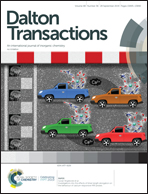Theoretical study of the photoconduction and photomagnetism of the BPY[Ni(dmit)2]2 molecular crystal
Abstract
The BPY[Ni(dmit)2]2 molecular crystal synthesized by Naito and coworkers (J. Am. Chem. Soc., 2012, 134, 18656) was characterized as a photo-magnetic-conductor. This crystal is a nonmagnetic semiconductor in the dark and becomes a magnetic conductor after UV irradiation. This work analyzes the key ingredients of the observed photomagnetism and photoconduction by means of wavefunction-based calculations on selected fragments and periodic calculations on the whole crystal. Our results demonstrate that UV-Vis light induces charge transfer processes between the closest [Ni(dmit)2]− and BPY2+ units, that introduce unpaired electrons on the unoccupied orbitals of the BPY cations. Since the conduction bands present a strong mixing of BPY and Ni(dmit)2, the optically activated anion–cation charge transfer enhances the conductivity. The photoinduced (BPY2+)* radicals can indeed interact with the close Ni(dmit)2 units, with non-negligible spin–spin magnetic couplings, which are responsible for the changes induced by the irradiation on the temperature dependence of the magnetic susceptibility.
![Graphical abstract: Theoretical study of the photoconduction and photomagnetism of the BPY[Ni(dmit)2]2 molecular crystal](/en/Image/Get?imageInfo.ImageType=GA&imageInfo.ImageIdentifier.ManuscriptID=C9DT03102B&imageInfo.ImageIdentifier.Year=2019)


 Please wait while we load your content...
Please wait while we load your content...